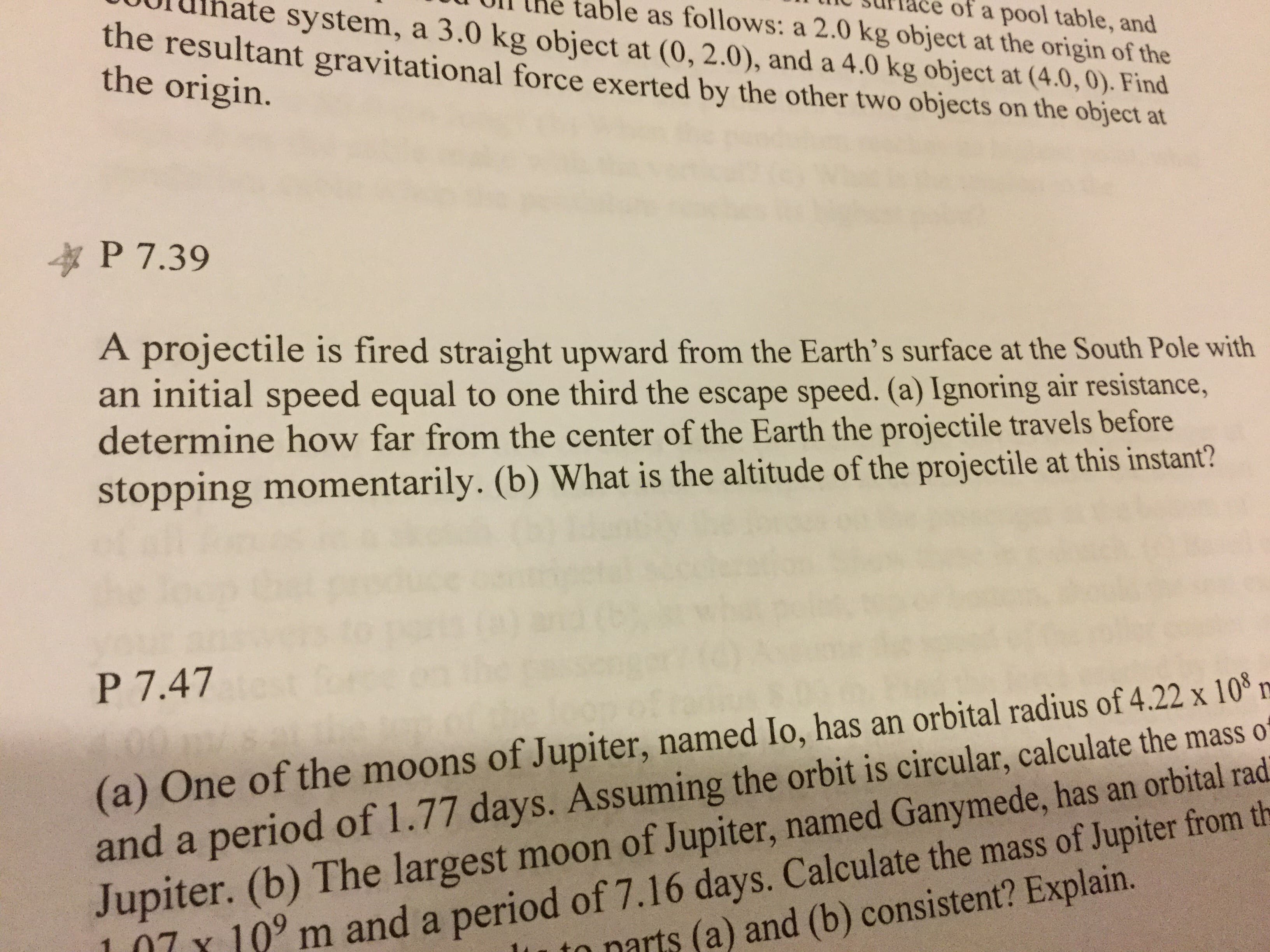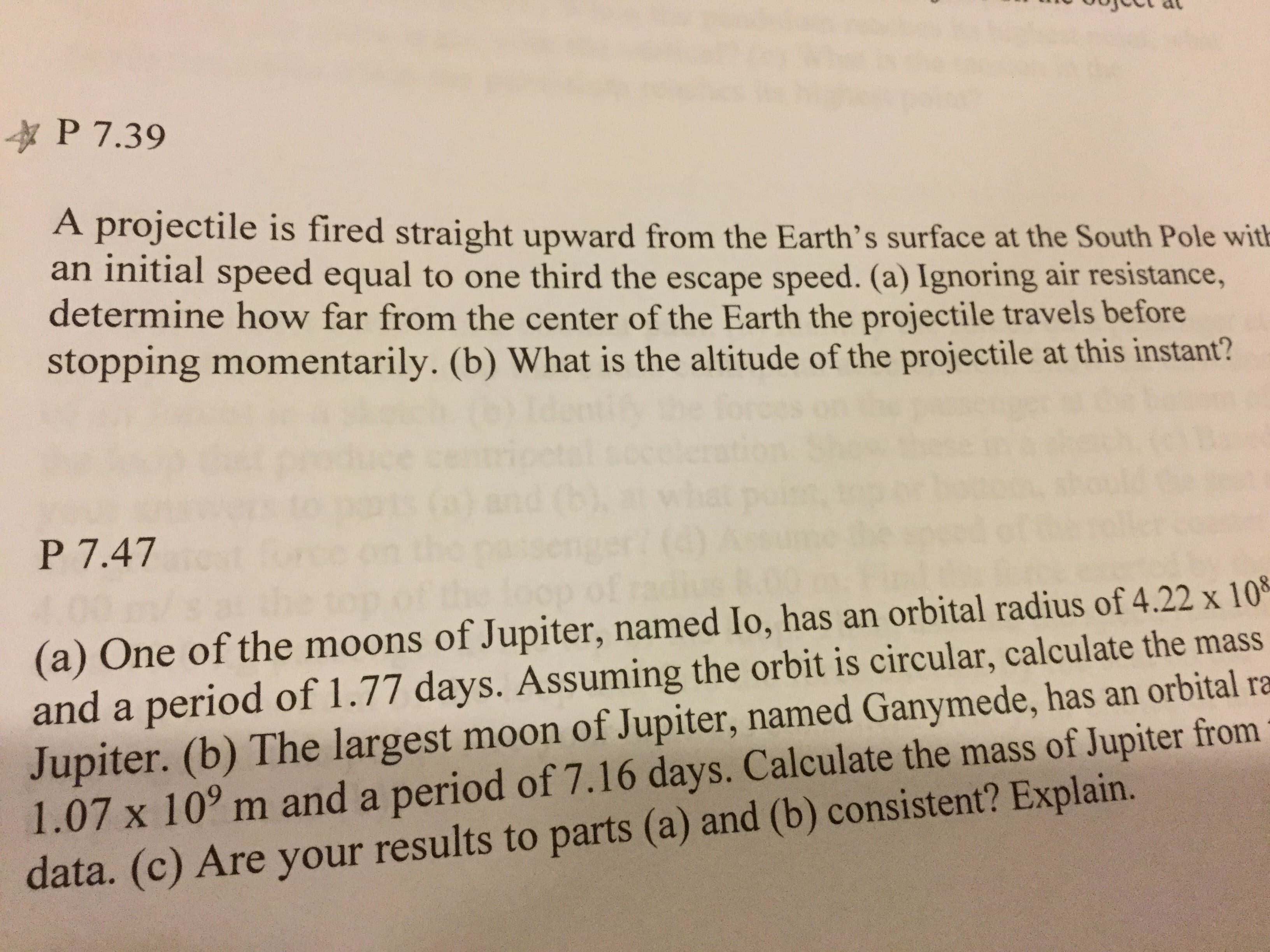of a pool table, and table as follows: a 2.0 kg object at the origin of the system, a 3.0 kg object at (0, 2.0), and a 4.0 kg object at (4.0, 0). Find the resultant gravitational force exerted by the other two objects on the object at the origin. P 7.39 A projectile is fired straight upward from the Earth's surface at the South Pole with an initial speed equal to one third the escape speed. (a) Ignoring air resistance, determine how far from the center of the Earth the projectile travels before stopping momentarily. (b) What is the altitude of the projectile at this instant? (a) One of the moons of Jupiter, named Io, has an orbital radius of 4.22 x 108 and a period of 1.77 days. Assuming the orbit is circular, calculate the mass o Jupiter. (b) The largest moon of Jupiter, named Ganymede, has an orbital rad 107 x 10° m and a period of 7.16 days. Calculate the mass of Jupiter from th P 7.47 narts (a) and (b) consistent? Explain. P 7.39 A projectile is fired straight upward from the Earth's surface at the South Pole with an initial speed equal to one third the escape speed. (a) Ignoring air resistance, determine how far from the center of the Earth the projectile travels before stopping momentarily. (b) What is the altitude of the projectile at this instant? P 7.47 (a) One of the moons of Jupiter, named Io, has an orbital radius of 4.22 x 10 and a period of 1.77 days. Assuming the orbit is circular, calculate the mass Jupiter. (b) The largest moon of Jupiter, named Ganymede, has an orbital ra 1.07 x 10° m and a period of 7.16 days. Calculate the mass of Jupiter from data. (c) Are your results to parts (a) and (b) consistent? Explain.
of a pool table, and table as follows: a 2.0 kg object at the origin of the system, a 3.0 kg object at (0, 2.0), and a 4.0 kg object at (4.0, 0). Find the resultant gravitational force exerted by the other two objects on the object at the origin. P 7.39 A projectile is fired straight upward from the Earth's surface at the South Pole with an initial speed equal to one third the escape speed. (a) Ignoring air resistance, determine how far from the center of the Earth the projectile travels before stopping momentarily. (b) What is the altitude of the projectile at this instant? (a) One of the moons of Jupiter, named Io, has an orbital radius of 4.22 x 108 and a period of 1.77 days. Assuming the orbit is circular, calculate the mass o Jupiter. (b) The largest moon of Jupiter, named Ganymede, has an orbital rad 107 x 10° m and a period of 7.16 days. Calculate the mass of Jupiter from th P 7.47 narts (a) and (b) consistent? Explain. P 7.39 A projectile is fired straight upward from the Earth's surface at the South Pole with an initial speed equal to one third the escape speed. (a) Ignoring air resistance, determine how far from the center of the Earth the projectile travels before stopping momentarily. (b) What is the altitude of the projectile at this instant? P 7.47 (a) One of the moons of Jupiter, named Io, has an orbital radius of 4.22 x 10 and a period of 1.77 days. Assuming the orbit is circular, calculate the mass Jupiter. (b) The largest moon of Jupiter, named Ganymede, has an orbital ra 1.07 x 10° m and a period of 7.16 days. Calculate the mass of Jupiter from data. (c) Are your results to parts (a) and (b) consistent? Explain.
Physics for Scientists and Engineers: Foundations and Connections
1st Edition
ISBN:9781133939146
Author:Katz, Debora M.
Publisher:Katz, Debora M.
Chapter7: Gravity
Section: Chapter Questions
Problem 11PQ
Related questions
Question
Can you help me on p. 7.39

Transcribed Image Text:of a pool table, and
table
as follows: a 2.0 kg object at the origin of the
system, a 3.0 kg object at (0, 2.0), and a 4.0 kg object at (4.0, 0). Find
the resultant gravitational force exerted by the other two objects on the object at
the origin.
P 7.39
A projectile is fired straight upward from the Earth's surface at the South Pole with
an initial speed equal to one third the escape speed. (a) Ignoring air resistance,
determine how far from the center of the Earth the projectile travels before
stopping momentarily. (b) What is the altitude of the projectile at this instant?
(a) One of the moons of Jupiter, named Io, has an orbital radius of 4.22 x 108
and a period of 1.77 days. Assuming the orbit is circular, calculate the mass o
Jupiter. (b) The largest moon of Jupiter, named Ganymede, has an orbital rad
107 x 10° m and a period of 7.16 days. Calculate the mass of Jupiter from th
P 7.47
narts (a) and (b) consistent? Explain.

Transcribed Image Text:P 7.39
A projectile is fired straight upward from the Earth's surface at the South Pole with
an initial speed equal to one third the escape speed. (a) Ignoring air resistance,
determine how far from the center of the Earth the projectile travels before
stopping momentarily. (b) What is the altitude of the projectile at this instant?
P 7.47
(a) One of the moons of Jupiter, named Io, has an orbital radius of 4.22 x 10
and a period of 1.77 days. Assuming the orbit is circular, calculate the mass
Jupiter. (b) The largest moon of Jupiter, named Ganymede, has an orbital ra
1.07 x 10° m and a period of 7.16 days. Calculate the mass of Jupiter from
data. (c) Are your results to parts (a) and (b) consistent? Explain.
Expert Solution
This question has been solved!
Explore an expertly crafted, step-by-step solution for a thorough understanding of key concepts.
This is a popular solution!
Trending now
This is a popular solution!
Step by step
Solved in 5 steps with 4 images

Knowledge Booster
Learn more about
Need a deep-dive on the concept behind this application? Look no further. Learn more about this topic, physics and related others by exploring similar questions and additional content below.Recommended textbooks for you

Physics for Scientists and Engineers: Foundations…
Physics
ISBN:
9781133939146
Author:
Katz, Debora M.
Publisher:
Cengage Learning

Classical Dynamics of Particles and Systems
Physics
ISBN:
9780534408961
Author:
Stephen T. Thornton, Jerry B. Marion
Publisher:
Cengage Learning

Principles of Physics: A Calculus-Based Text
Physics
ISBN:
9781133104261
Author:
Raymond A. Serway, John W. Jewett
Publisher:
Cengage Learning

Physics for Scientists and Engineers: Foundations…
Physics
ISBN:
9781133939146
Author:
Katz, Debora M.
Publisher:
Cengage Learning

Classical Dynamics of Particles and Systems
Physics
ISBN:
9780534408961
Author:
Stephen T. Thornton, Jerry B. Marion
Publisher:
Cengage Learning

Principles of Physics: A Calculus-Based Text
Physics
ISBN:
9781133104261
Author:
Raymond A. Serway, John W. Jewett
Publisher:
Cengage Learning

University Physics Volume 1
Physics
ISBN:
9781938168277
Author:
William Moebs, Samuel J. Ling, Jeff Sanny
Publisher:
OpenStax - Rice University

Glencoe Physics: Principles and Problems, Student…
Physics
ISBN:
9780078807213
Author:
Paul W. Zitzewitz
Publisher:
Glencoe/McGraw-Hill